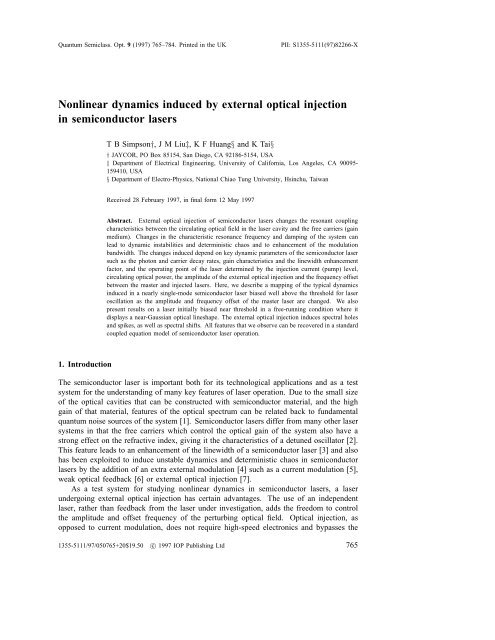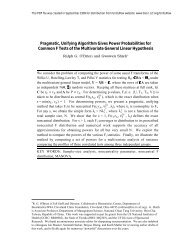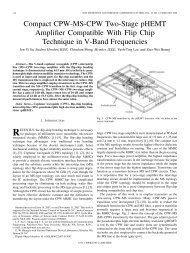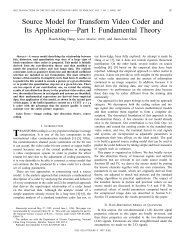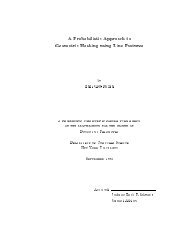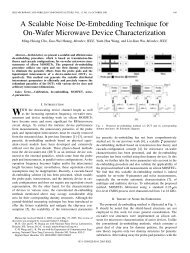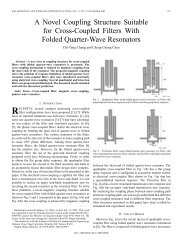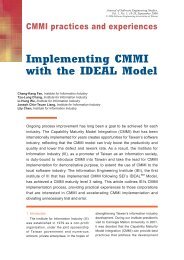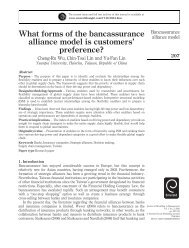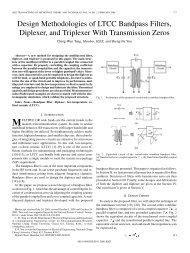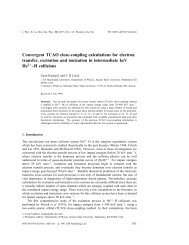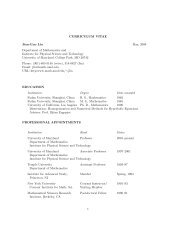Nonlinear dynamics induced by external optical injection in ...
Nonlinear dynamics induced by external optical injection in ...
Nonlinear dynamics induced by external optical injection in ...
Create successful ePaper yourself
Turn your PDF publications into a flip-book with our unique Google optimized e-Paper software.
Quantum Semiclass. Opt. 9 (1997) 765–784. Pr<strong>in</strong>ted <strong>in</strong> the UK<br />
PII: S1355-5111(97)82266-X<br />
<strong>Nonl<strong>in</strong>ear</strong> <strong>dynamics</strong> <strong><strong>in</strong>duced</strong> <strong>by</strong> <strong>external</strong> <strong>optical</strong> <strong><strong>in</strong>jection</strong><br />
<strong>in</strong> semiconductor lasers<br />
T B Simpson†, JMLiu‡, K F Huang§ and K Tai§<br />
† JAYCOR, PO Box 85154, San Diego, CA 92186-5154, USA<br />
‡ Department of Electrical Eng<strong>in</strong>eer<strong>in</strong>g, University of California, Los Angeles, CA 90095-<br />
159410, USA<br />
§ Department of Electro-Physics, National Chiao Tung University, Hs<strong>in</strong>chu, Taiwan<br />
Received 28 February 1997, <strong>in</strong> f<strong>in</strong>al form 12 May 1997<br />
Abstract. External <strong>optical</strong> <strong><strong>in</strong>jection</strong> of semiconductor lasers changes the resonant coupl<strong>in</strong>g<br />
characteristics between the circulat<strong>in</strong>g <strong>optical</strong> field <strong>in</strong> the laser cavity and the free carriers (ga<strong>in</strong><br />
medium). Changes <strong>in</strong> the characteristic resonance frequency and damp<strong>in</strong>g of the system can<br />
lead to dynamic <strong>in</strong>stabilities and determ<strong>in</strong>istic chaos and to enhancement of the modulation<br />
bandwidth. The changes <strong><strong>in</strong>duced</strong> depend on key dynamic parameters of the semiconductor laser<br />
such as the photon and carrier decay rates, ga<strong>in</strong> characteristics and the l<strong>in</strong>ewidth enhancement<br />
factor, and the operat<strong>in</strong>g po<strong>in</strong>t of the laser determ<strong>in</strong>ed <strong>by</strong> the <strong><strong>in</strong>jection</strong> current (pump) level,<br />
circulat<strong>in</strong>g <strong>optical</strong> power, the amplitude of the <strong>external</strong> <strong>optical</strong> <strong><strong>in</strong>jection</strong> and the frequency offset<br />
between the master and <strong>in</strong>jected lasers. Here, we describe a mapp<strong>in</strong>g of the typical <strong>dynamics</strong><br />
<strong><strong>in</strong>duced</strong> <strong>in</strong> a nearly s<strong>in</strong>gle-mode semiconductor laser biased well above the threshold for laser<br />
oscillation as the amplitude and frequency offset of the master laser are changed. We also<br />
present results on a laser <strong>in</strong>itially biased near threshold <strong>in</strong> a free-runn<strong>in</strong>g condition where it<br />
displays a near-Gaussian <strong>optical</strong> l<strong>in</strong>eshape. The <strong>external</strong> <strong>optical</strong> <strong><strong>in</strong>jection</strong> <strong>in</strong>duces spectral holes<br />
and spikes, as well as spectral shifts. All features that we observe can be recovered <strong>in</strong> a standard<br />
coupled equation model of semiconductor laser operation.<br />
1. Introduction<br />
The semiconductor laser is important both for its technological applications and as a test<br />
system for the understand<strong>in</strong>g of many key features of laser operation. Due to the small size<br />
of the <strong>optical</strong> cavities that can be constructed with semiconductor material, and the high<br />
ga<strong>in</strong> of that material, features of the <strong>optical</strong> spectrum can be related back to fundamental<br />
quantum noise sources of the system [1]. Semiconductor lasers differ from many other laser<br />
systems <strong>in</strong> that the free carriers which control the <strong>optical</strong> ga<strong>in</strong> of the system also have a<br />
strong effect on the refractive <strong>in</strong>dex, giv<strong>in</strong>g it the characteristics of a detuned oscillator [2].<br />
This feature leads to an enhancement of the l<strong>in</strong>ewidth of a semiconductor laser [3] and also<br />
has been exploited to <strong>in</strong>duce unstable <strong>dynamics</strong> and determ<strong>in</strong>istic chaos <strong>in</strong> semiconductor<br />
lasers <strong>by</strong> the addition of an extra <strong>external</strong> modulation [4] such as a current modulation [5],<br />
weak <strong>optical</strong> feedback [6] or <strong>external</strong> <strong>optical</strong> <strong><strong>in</strong>jection</strong> [7].<br />
As a test system for study<strong>in</strong>g nonl<strong>in</strong>ear <strong>dynamics</strong> <strong>in</strong> semiconductor lasers, a laser<br />
undergo<strong>in</strong>g <strong>external</strong> <strong>optical</strong> <strong><strong>in</strong>jection</strong> has certa<strong>in</strong> advantages. The use of an <strong>in</strong>dependent<br />
laser, rather than feedback from the laser under <strong>in</strong>vestigation, adds the freedom to control<br />
the amplitude and offset frequency of the perturb<strong>in</strong>g <strong>optical</strong> field. Optical <strong><strong>in</strong>jection</strong>, as<br />
opposed to current modulation, does not require high-speed electronics and <strong>by</strong>passes the<br />
1355-5111/97/050765+20$19.50 c○ 1997 IOP Publish<strong>in</strong>g Ltd 765
766 T B Simpson et al<br />
electronic parasitic effects that can obscure the <strong>in</strong>tr<strong>in</strong>sic laser properties. Experimental<br />
<strong>in</strong>vestigations of nonl<strong>in</strong>ear <strong>dynamics</strong> <strong>in</strong> a conventional edge-emitt<strong>in</strong>g Fabry–Perot laser<br />
diode biased well above threshold have shown quantitative agreement with a coupled<br />
equation model for s<strong>in</strong>gle-mode laser operation [7–10]. Here, we extend that work and<br />
present the results <strong>in</strong> the form of a mapp<strong>in</strong>g of the observed <strong>dynamics</strong> of the laser output<br />
as a function of the amplitude and detun<strong>in</strong>g of the <strong>external</strong> <strong>optical</strong> <strong><strong>in</strong>jection</strong>. Many features<br />
of the observed <strong>dynamics</strong> are expected to appear <strong>in</strong> a variety of laser structures, while<br />
some relate to characteristics of the specific laser structure. We also present results on<br />
<strong>optical</strong> <strong><strong>in</strong>jection</strong> of a vertical-cavity surface-emitt<strong>in</strong>g laser (VCSEL) which, <strong>in</strong> its freerunn<strong>in</strong>g<br />
condition, is biased near threshold with an <strong>optical</strong> output with a near-Gaussian,<br />
as opposed to a Lorentzian, spectrum. When the <strong>external</strong> <strong>optical</strong> <strong><strong>in</strong>jection</strong> destabilizes<br />
the <strong>dynamics</strong> of this system, the <strong>optical</strong> spectrum shows spectral spikes and holes <strong>in</strong> the<br />
Gaussian envelope. As before, all of the results can be reproduced with the coupled equation<br />
model.<br />
2. Experimental apparatus<br />
Figure 1 shows the experimental set-up. The output of one laser diode (LD1) at a frequency<br />
ν 1 was passed through an acousto-optic modulator where a fraction, on the order of 10%,<br />
of the beam was deflected and shifted <strong>in</strong> frequency <strong>by</strong> 80 MHz. The shifted beam at<br />
ν 1 + 80 MHz was used to probe a second laser (LD2) oscillat<strong>in</strong>g at ν 0 = ω 0 /2π. Thus<br />
the frequency offset f = /2π is given <strong>by</strong> ν 0 + f = ν 1 + 80 MHz and can be varied<br />
<strong>by</strong> vary<strong>in</strong>g ν 1 . Both lasers were temperature and current stabilized. To br<strong>in</strong>g them to<br />
near-degenerate operat<strong>in</strong>g frequencies, the temperature was adjusted for gross frequency<br />
changes and then the current was adjusted for f<strong>in</strong>e tun<strong>in</strong>g of the frequency offset f . Optical<br />
Figure 1. Schematic diagram of the experimental set-up.
<strong>Nonl<strong>in</strong>ear</strong> <strong>dynamics</strong> <strong>in</strong> semiconductor lasers 767<br />
isolators were used to avoid mutual <strong><strong>in</strong>jection</strong> and to reject back-reflected light from any<br />
components <strong>in</strong> the <strong>optical</strong> path. The use of the acousto-optic modulator improved the<br />
<strong>optical</strong> isolation between the two lasers. It could be removed and the full output of LD1<br />
could be directed toward LD2 when high <strong><strong>in</strong>jection</strong> levels were required. The output of the<br />
<strong>in</strong>jected laser was monitored us<strong>in</strong>g both <strong>optical</strong> and microwave/radio-frequency spectrum<br />
analysers to measure both the <strong>optical</strong> field and power spectra. The data presented here were<br />
taken us<strong>in</strong>g the <strong>optical</strong> spectrum analyser. However, both spectra are necessary for the<br />
determ<strong>in</strong>ation of key dynamic parameters required for the comparison of experimental data<br />
with numerical data [11]. Measur<strong>in</strong>g both spectra simultaneously allowed us to dist<strong>in</strong>guish<br />
between amplitude and phase modulations of the output of the <strong>in</strong>jected laser. The <strong>optical</strong><br />
spectrum was measured with a Newport SR-240C scann<strong>in</strong>g Fabry–Perot <strong>in</strong>terferometer<br />
which has a free spectral range of 2 THz and a f<strong>in</strong>esse of approximately 50 000, giv<strong>in</strong>g<br />
an <strong>optical</strong> frequency resolution of about 40 MHz. The power spectrum was obta<strong>in</strong>ed <strong>by</strong><br />
detect<strong>in</strong>g the output of the <strong>in</strong>jected laser with a fast photodiode of 7 GHz frequency response<br />
and display<strong>in</strong>g the photodiode signal on the spectrum analyser. In this experiment, the beam<br />
block B2 was removed to allow the <strong>optical</strong> spectrum measurement, while the beam block<br />
B1 <strong>in</strong> the path of ν 1 was <strong>in</strong>serted to block off the master laser output at ν 1 from the<br />
detection system. This allowed the direct measurement of the output from the <strong>in</strong>jected<br />
laser.<br />
In the data presented here, two sets of master–<strong>in</strong>jected laser comb<strong>in</strong>ations were used.<br />
The first set consisted of two Spectra Diode Labs SDL-5301-G1 s<strong>in</strong>gle longitud<strong>in</strong>al and<br />
transverse mode GaAs–AlGaAs quantum-well lasers operat<strong>in</strong>g at 827.6 nm. These lasers<br />
are conventional Fabry–Perot edge-emitt<strong>in</strong>g lasers with one facet coated for high reflection<br />
and the output facet coated for a reflection of a few per cent. The threshold current for<br />
the <strong>in</strong>jected laser was approximately 24 mA and the data presented here were taken at an<br />
<strong><strong>in</strong>jection</strong> current level of 40 mA. The oscillat<strong>in</strong>g mode conta<strong>in</strong>ed approximately 90% of<br />
the output power of the free-runn<strong>in</strong>g laser, with the rest spread among many sub-threshold<br />
longitud<strong>in</strong>al modes. None of the side modes of the free-runn<strong>in</strong>g laser conta<strong>in</strong>ed greater than<br />
0.5% of the total output power. The master laser, with a threshold current of approximately<br />
18 mA, was operated at a higher current level, approximately 55–65 mA. The higher<br />
operat<strong>in</strong>g current reduced the magnitude of the noise and <strong>in</strong>creased the frequency and<br />
damp<strong>in</strong>g of the relaxation resonance. Like the <strong>in</strong>jected laser, the master laser had many<br />
weak sub-threshold longitud<strong>in</strong>al modes, none strong enough to play a significant role <strong>in</strong><br />
the results described here. The second set consisted of a New Focus Model 6226 tunable<br />
<strong>external</strong> cavity laser as the master laser and a vertical-cavity surface-emitt<strong>in</strong>g laser (VCSEL)<br />
as the <strong>in</strong>jected laser. The VCSEL had a threshold for laser oscillation of approximately<br />
3.9 mA and emission wavelength of approximately 850 nm [14–16]. The output was <strong>in</strong> a<br />
s<strong>in</strong>gle polarization direction and a s<strong>in</strong>gle longitud<strong>in</strong>al and spatial mode over the range of<br />
<strong><strong>in</strong>jection</strong> currents discussed here.<br />
3. Coupled equation model<br />
Semiconductor lasers have been the subject of extensive modell<strong>in</strong>g. They are an example<br />
of a class-B laser system where the equation describ<strong>in</strong>g the polarization of the ga<strong>in</strong> medium<br />
can be adiabatically elim<strong>in</strong>ated due to the fast <strong>in</strong>traband carrier relaxation time [2]. This<br />
leaves two equations, one for the complex oscillat<strong>in</strong>g field with<strong>in</strong> the laser cavity and one<br />
for the carrier density, to describe the <strong>dynamics</strong> of the s<strong>in</strong>gle-mode laser under <strong>external</strong>
768 T B Simpson et al<br />
<strong>optical</strong> <strong><strong>in</strong>jection</strong> [11, 17]:<br />
dA<br />
=− γ c<br />
dt 2 A+i(ω 0 − ω c )A + Ɣ 2 (1 − ib)gA + F + ηA i exp(−it) (1)<br />
dN<br />
= J dt ed − γ sN − 2ɛ 0n 2<br />
g|A| 2 (2)<br />
¯hω 0<br />
where A is the total complex <strong>in</strong>tracavity field amplitude at the oscillation frequency ω 0 ,γ c<br />
is the cavity decay rate and ω c is the longitud<strong>in</strong>al mode frequency of the cold laser cavity.<br />
Ɣ is the conf<strong>in</strong>ement factor which gives the spatial overlap between the active ga<strong>in</strong> volume<br />
and the <strong>optical</strong> mode volume, b is the l<strong>in</strong>ewidth enhancement factor which relates the<br />
dependence of the refractive <strong>in</strong>dex to changes <strong>in</strong> the ga<strong>in</strong>, g. The ga<strong>in</strong> is assumed to obey<br />
a l<strong>in</strong>ear dependence on changes <strong>in</strong> the carrier density, with coefficient g N , and changes <strong>in</strong><br />
the photon density, with coefficient g p , about an appropriately chosen operat<strong>in</strong>g po<strong>in</strong>t [11].<br />
N is the carrier density, J is the <strong><strong>in</strong>jection</strong> current density, e is the electronic charge, d is<br />
the active layer thickness, γ s is the spontaneous carrier decay rate and n is the refractive<br />
<strong>in</strong>dex of the semiconductor medium. Two source terms <strong>in</strong> the field equation are due to:<br />
(i) <strong>external</strong> <strong>optical</strong> <strong><strong>in</strong>jection</strong> where η is the coupl<strong>in</strong>g parameter, A i the amplitude of the<br />
<strong>external</strong> field and the offset frequency with respect to the free-runn<strong>in</strong>g frequency of the<br />
<strong>in</strong>jected laser and (ii) noise. F is the complex Langev<strong>in</strong> source term for the field noise due<br />
to spontaneous emission <strong>in</strong>to the mode and <strong>external</strong> coupl<strong>in</strong>g out of the mode [1, 3]:<br />
〈F(t)〉=0 (3)<br />
〈F(t)F ∗ (t ′ )〉=R sp δ(t − t ′ ) (4)<br />
〈F(t)F(t ′ )〉=0 (5)<br />
where R sp gives the strength of the field source term. The noise source terms <strong>in</strong> the carrier<br />
equation are omitted. They are relatively unimportant <strong>in</strong> determ<strong>in</strong><strong>in</strong>g the <strong>optical</strong> field spectra<br />
which we will emphasize.<br />
4. Semiconductor laser above threshold<br />
When a semiconductor laser is subjected to <strong><strong>in</strong>jection</strong> <strong>by</strong> a near-resonant <strong>external</strong> <strong>optical</strong><br />
field, the laser output will exhibit a variety of <strong>optical</strong> spectra. By comparison between the<br />
experimentally observed spectra and the calculated spectra, we have been able to categorize<br />
the <strong>dynamics</strong>. When the laser is biased well above threshold, the steady-state, free-runn<strong>in</strong>g<br />
operat<strong>in</strong>g condition is used as the reference po<strong>in</strong>t for the ga<strong>in</strong> <strong>in</strong> the calculations. The<br />
field amplitude and cavity density variations are normalized with respect to the steadystate<br />
<strong>optical</strong> field, A 0 , and carrier density, N 0 , respectively. The equations can then be<br />
rewritten as three coupled real equations for the normalized field, a, <strong>optical</strong> phase, φ, and<br />
normalized carrier density, ñ, <strong>in</strong> a form which shows explicitly the dependence on specific<br />
laser parameters which can be experimentally determ<strong>in</strong>ed <strong>in</strong> the weak <strong><strong>in</strong>jection</strong> limit [8]:<br />
da<br />
dt<br />
dφ<br />
dt<br />
dñ<br />
dt<br />
= 1 [ ]<br />
γn γ c<br />
2 γ s J˜<br />
ñ − γ p(2a + a 2 ) (1 + a) + γ c ξ cos(t + φ) + F ′ /|A 0 | (6)<br />
=− b [ ]<br />
γn γ c<br />
2 γ s J˜<br />
ñ−γ p(2a+a 2 ) − γ cξs<strong>in</strong>(t + φ) − F ′′ /|A 0 |<br />
(7)<br />
1 + a<br />
[<br />
=−[γ s +γ n (1+a) 2 ]ñ − γ s J˜<br />
1 − γ p<br />
γ c<br />
(1 + a) 2 ]<br />
(2a + a 2 ). (8)
<strong>Nonl<strong>in</strong>ear</strong> <strong>dynamics</strong> <strong>in</strong> semiconductor lasers 769<br />
Figure 2. Mapp<strong>in</strong>g of the lock<strong>in</strong>g and stability characteristics of the conventional, edge-emitt<strong>in</strong>g<br />
semiconductor laser with J ˜ = 2 3 as a function of the frequency offset between the lock<strong>in</strong>g and<br />
free-runn<strong>in</strong>g laser fields and the <strong><strong>in</strong>jection</strong> parameter, ξ. The thick full curves are the boundary of<br />
the <strong><strong>in</strong>jection</strong>-locked region. Shown <strong>in</strong> the <strong>in</strong>terior of the lock<strong>in</strong>g region is the Hopf bifurcation<br />
l<strong>in</strong>e (thick broken curve) separat<strong>in</strong>g the stable and unstable operat<strong>in</strong>g regimes. The positive<br />
frequency boundary of the locked region is a l<strong>in</strong>e of constant output field amplitude at the<br />
free-runn<strong>in</strong>g level, A 0 . Also shown are the curves for 1.1A 0 (dotted) and 1.2A 0 (broken).<br />
Here, a = (|A| −|A 0 |)/|A 0 |, φ is the phase difference between A and A i and ñ =<br />
(N −N 0 )/N 0 . The <strong><strong>in</strong>jection</strong> parameter, ξ, describ<strong>in</strong>g the <strong>external</strong> <strong>optical</strong> <strong><strong>in</strong>jection</strong> is def<strong>in</strong>ed<br />
as ξ = η|A i |/γ c |A 0 | and the <strong>in</strong>jected power is proportional to ξ 2 . The decay rates γ n and<br />
γ p are the differential stimulated emission rate and ga<strong>in</strong> saturation rates, formed from the<br />
steady-state photon density and g N and g p , respectively [11]. J ˜ = (J/ed − γ s N 0 )/γ s N 0 ,<br />
where J/ed is the carrier density <strong><strong>in</strong>jection</strong> rate. All the <strong>in</strong>put parameters required to solve<br />
the set of coupled differential equations numerically for a,φ and ñ can be determ<strong>in</strong>ed<br />
experimentally [11]. After numerical <strong>in</strong>tegration of the normalized coupled equations, the<br />
result<strong>in</strong>g time series are Fourier transformed to calculate the spectra.<br />
Some key features can be predicted from a perturbation analysis with the set of coupled<br />
equations which assumes that the changes to the amplitude, phase and carrier density are<br />
sufficiently small that the three equations can be l<strong>in</strong>earized. Figure 2 shows a typical<br />
mapp<strong>in</strong>g of the predicted lock<strong>in</strong>g and stability range based on a l<strong>in</strong>earized analysis [12].<br />
The actual values used to calculate the map correspond to the <strong>in</strong>jected SDL laser at the bias<br />
current of 40 mA, J ˜ = 2 , but the qualitative characteristics are more general. The analysis<br />
3<br />
predicts an asymmetric lock<strong>in</strong>g range [13] with a bounded range of unstable operation<br />
with<strong>in</strong> the lock<strong>in</strong>g range. The circulat<strong>in</strong>g field amplitude <strong>in</strong>creases with <strong>in</strong>creas<strong>in</strong>g <strong><strong>in</strong>jection</strong><br />
parameter and/or decreas<strong>in</strong>g offset frequency with<strong>in</strong> the locked region. A larger value of b<br />
<strong>in</strong>creases the low-frequency boundary of the locked operat<strong>in</strong>g range and <strong>in</strong>creases the range<br />
of the unstable <strong>dynamics</strong>. A larger value of J˜<br />
shifts the unstable region to larger values of<br />
ξ with the low-ξ limit shift<strong>in</strong>g approximately <strong>in</strong> proportion to J˜<br />
or A 2 0<br />
and the upper limit<br />
shift<strong>in</strong>g approximately with A 0 [12]. The analysis also predicts that the eigenvalues of the<br />
coupled equations are strong functions of the operat<strong>in</strong>g po<strong>in</strong>t. Figure 3 plots the eigenvalues,<br />
or resonance frequencies of the field-free carrier coupl<strong>in</strong>g, as a function of ξ for two<br />
different cases. The first case is for <strong>external</strong> <strong>optical</strong> <strong><strong>in</strong>jection</strong> at the free-runn<strong>in</strong>g frequency<br />
of the <strong>in</strong>jected laser. This corresponds to a phase offset of arctan b between the master and<br />
<strong>in</strong>jected laser <strong>optical</strong> fields <strong>in</strong> the l<strong>in</strong>earized analysis. For this case the resonance frequencies<br />
<strong>in</strong>crease monotonically with ξ. In contrast, when the <strong><strong>in</strong>jection</strong> frequency is changed as ξ is
770 T B Simpson et al<br />
Figure 3. Calculated eigenfrequency and measured frequency of the <strong>optical</strong> spectrum sideband<br />
peak for the conventional, edge-emitt<strong>in</strong>g semiconductor laser with J ˜ = 2 3 as a function of the<br />
<strong><strong>in</strong>jection</strong> parameter, ξ. Two cases are plotted: full curve and squares, <strong><strong>in</strong>jection</strong> at the freerunn<strong>in</strong>g<br />
<strong>optical</strong> frequency; broken curve and triangles, <strong><strong>in</strong>jection</strong> correspond<strong>in</strong>g to φ L = 0. The<br />
former case shows unstable operation for 0.007
<strong>Nonl<strong>in</strong>ear</strong> <strong>dynamics</strong> <strong>in</strong> semiconductor lasers 771<br />
Figure 4. Measured <strong>optical</strong> spectra of the conventional, edge-emitt<strong>in</strong>g semiconductor laser with<br />
J ˜ = 2 3 under <strong>optical</strong> <strong><strong>in</strong>jection</strong> at the free-runn<strong>in</strong>g <strong>optical</strong> frequency: (a) free-runn<strong>in</strong>g operation<br />
with an expanded scale show<strong>in</strong>g the relaxation resonance sidebands; (b) unstable <strong><strong>in</strong>jection</strong><br />
lock<strong>in</strong>g, limit cycle, at ξ 2 = 1 × 10 −4 with an expanded scale spectrum; (c) period doubl<strong>in</strong>g<br />
at ξ 2 = 3 × 10 −4 with features shown clearly <strong>in</strong> the expanded scale; (d) chaotic <strong>dynamics</strong> at<br />
ξ 2 = 1.3×10 −3 ;(e) limit cycle at ξ 2 = 3.6×10 −3 ;(f) period doubl<strong>in</strong>g at ξ 2 = 7.2×10 −3 ;(g)<br />
transition back to the limit cycle at ξ 2 = 1.7 × 10 −2 and (h) stable operation at ξ 2 = 8.5 × 10 −2<br />
along with an expanded scale spectrum and the expanded scale sideband spectrum of the master<br />
laser.
772 T B Simpson et al<br />
spectra, sharp period-doubl<strong>in</strong>g peaks result [8]. In figure 4(d), ξ 2 = 1.3 × 10 −3 , the<br />
spectrum becomes dom<strong>in</strong>ated <strong>by</strong> a broad pedestal and many secondary peaks develop.<br />
Relatively little energy rema<strong>in</strong>s <strong>in</strong> the narrow <strong><strong>in</strong>jection</strong> spike. At this stage the spectra<br />
<strong>in</strong>dicated that chaos has fully developed [7]. Because of the high frequencies <strong>in</strong>volved,<br />
an experimentally measured time series of the laser output could not be obta<strong>in</strong>ed. The<br />
onset of determ<strong>in</strong>istic chaos was confirmed <strong>by</strong> the observation of strange attractors <strong>in</strong><br />
the phase space of a,φ and ñ from numerically generated time series obta<strong>in</strong>ed from the<br />
coupled equations without the field noise source terms. Calculated spectra qualitatively like<br />
figure 4(d), with the broad pedestal and irregular secondary peaks, were also consistently<br />
associated with a positive Lyupanov exponent [18]. With<strong>in</strong> the region of chaotic <strong>dynamics</strong>,<br />
a fraction of the oscillat<strong>in</strong>g power, <strong>in</strong>creas<strong>in</strong>g up to 35% as the <strong><strong>in</strong>jection</strong> level is <strong>in</strong>creased,<br />
is shifted from the pr<strong>in</strong>cipal oscillat<strong>in</strong>g mode <strong>in</strong>to several of the weak side modes. Over a<br />
narrow <strong><strong>in</strong>jection</strong> range, the broadened spectrum collapses aga<strong>in</strong> <strong>in</strong>to an equally spaced set<br />
of narrow features, as shown <strong>in</strong> figure 4(e) where ξ 2 = 3.6 × 10 −3 and the pr<strong>in</strong>cipal mode<br />
rega<strong>in</strong>s its full power [7]. Now, however, the separation of the peaks has <strong>in</strong>creased and the<br />
spectrum is shifted much more strongly to the negative components. At still higher <strong><strong>in</strong>jection</strong><br />
levels, figure 4(f ) where ξ 2 = 7.2 × 10 −3 , a new, clear period doubl<strong>in</strong>g is observed with a<br />
further <strong>in</strong>crease of the peak separation and relative strengthen<strong>in</strong>g of the negative frequency<br />
components. The strongest spectral feature is clearly frequency-shifted—pushed <strong>by</strong> the<br />
resonant <strong><strong>in</strong>jection</strong>. The period-doubl<strong>in</strong>g peaks then steadily decrease <strong>in</strong> amplitude as the<br />
resonance peak monotonically <strong>in</strong>creases while the peak separation cont<strong>in</strong>ues to <strong>in</strong>crease.<br />
The spectra <strong>in</strong> figure 4(g) are observed when ξ 2 = 1.7 × 10 −2 and the <strong><strong>in</strong>jection</strong> peak aga<strong>in</strong><br />
beg<strong>in</strong>s to dom<strong>in</strong>ate the spectrum. Eventually, the side peaks decrease <strong>in</strong> magnitude so<br />
that only a s<strong>in</strong>gle peak at the <strong><strong>in</strong>jection</strong> frequency dom<strong>in</strong>ates the spectrum. In figure 4(h)<br />
ξ 2 = 8.5 × 10 −2 and stable <strong>dynamics</strong> has been re-established. The peak separation has<br />
now <strong>in</strong>creased to 10.5 GHz and the side peak is visible <strong>in</strong> the expanded spectrum. Also<br />
visible <strong>in</strong> the expanded spectrum are replicas of the relaxation resonance features of the<br />
master laser. The identification of these features is confirmed <strong>by</strong> comparison with the<br />
sideband spectrum of the master laser, which is also shown. At high <strong><strong>in</strong>jection</strong> levels,<br />
the noise sidebands of the master laser appear <strong>in</strong> the spectrum of the <strong><strong>in</strong>jection</strong>-locked<br />
slave. These noise features do not reflect the <strong>dynamics</strong> of the <strong>in</strong>jected laser system. The<br />
<strong>dynamics</strong> are reflected <strong>in</strong> the shifted resonance feature. Note that the strong asymmetry of<br />
the resonance peaks cont<strong>in</strong>ues when stable <strong>dynamics</strong> has been re-established. The weak<br />
asymmetry <strong>in</strong> the resonance peaks of the free-runn<strong>in</strong>g laser has become a strong asymmetry<br />
<strong>in</strong> the <strong><strong>in</strong>jection</strong>-locked laser. The measured shift <strong>in</strong> the resonance peaks is compared with<br />
the calculated eigenfrequencies of the coupled equations <strong>in</strong> figure 3 and shows very good<br />
agreement with the full nonl<strong>in</strong>ear calculation and reasonable agreement with the l<strong>in</strong>earized<br />
treatment.<br />
Before proceed<strong>in</strong>g to a more general picture of the <strong>dynamics</strong> <strong><strong>in</strong>duced</strong> under <strong>external</strong><br />
<strong>optical</strong> <strong><strong>in</strong>jection</strong>, we dist<strong>in</strong>guish a special type of period-doubl<strong>in</strong>g-like spectra, the region<br />
of subharmonic resonance [10]. Figure 5 shows a set of spectra which illustrates the<br />
subharmonic resonance. Aga<strong>in</strong>, the offset frequency is referenced to the frequency of the<br />
free-runn<strong>in</strong>g laser. In these spectra the master laser is offset <strong>by</strong> ≈5.5 GHz and the <strong><strong>in</strong>jection</strong><br />
level is varied. A complementary set of spectra, where the <strong><strong>in</strong>jection</strong> level is held constant<br />
while the offset frequency is varied from below to above twice the relaxation resonance<br />
frequency of the free-runn<strong>in</strong>g laser, has been presented elsewhere [10]. At low <strong><strong>in</strong>jection</strong><br />
levels the spectrum consists of narrow, weak sidebands, equally and oppositely offset from<br />
a ma<strong>in</strong> peak with its relaxation resonance sidebands, as shown <strong>in</strong> figure 5(a). These narrow<br />
features are due to regenerative amplification of the <strong>in</strong>jected signal and four-wave mix<strong>in</strong>g
<strong>Nonl<strong>in</strong>ear</strong> <strong>dynamics</strong> <strong>in</strong> semiconductor lasers 773<br />
Figure 5. Measured <strong>optical</strong> spectra of the conventional, edge-emitt<strong>in</strong>g semiconductor laser<br />
with J ˜ = 2 3 under <strong>optical</strong> <strong><strong>in</strong>jection</strong> at a frequency offset ≈5.5 GHz: (a) weak <strong><strong>in</strong>jection</strong> with<br />
regenerative amplification and four-wave mix<strong>in</strong>g sidebands; (b) enhanced subharmonic signal at<br />
ξ 2 = 2.1 × 10 −4 ;(c) subharmonic resonance at ξ 2 = 4 × 10 −4 ;(d) weak period quadrupl<strong>in</strong>g at<br />
ξ 2 = 2.6 × 10 −3 ;(e) period doubl<strong>in</strong>g at ξ 2 = 6 × 10 −3 and (f ) limit cycle at ξ 2 = 1.2 × 10 −2 .<br />
between the <strong>in</strong>jected signal and the central peak [11]. As the <strong>in</strong>jected signal is <strong>in</strong>creased, the<br />
spectral features near the relaxation resonance frequency narrow and <strong>in</strong>crease, figure 5(b)<br />
where the <strong><strong>in</strong>jection</strong> level is ξ 2 = 2.1 × 10 −4 . Note, however, that these features are halfway<br />
between the <strong><strong>in</strong>jection</strong> feature, or its oppositely shifted partner and the central peak. This<br />
frequency is slightly less than the relaxation resonance frequency of the free-runn<strong>in</strong>g laser.<br />
There is also a small frequency push<strong>in</strong>g of the central peak. At still higher <strong><strong>in</strong>jection</strong> levels,<br />
figure 5(c) with ξ 2 = 4 × 10 −4 , the subharmonic resonance nature of the <strong>dynamics</strong> becomes<br />
clear. The sideband at the <strong><strong>in</strong>jection</strong> frequency is now dom<strong>in</strong>ated <strong>by</strong> the feature at half<br />
the offset. Also, the frequency push<strong>in</strong>g has stopped and the central peak is slightly pulled<br />
toward the <strong>in</strong>jected frequency [10]. As the <strong><strong>in</strong>jection</strong> level is <strong>in</strong>creased to ξ 2 = 2.6 × 10 −3 ,<br />
figure 5(d), the push<strong>in</strong>g of the central peak and the dom<strong>in</strong>ance of the resonance frequency,<br />
now significantly larger than the <strong>in</strong>itial offset frequency, are re-established. This is actually<br />
a period-quadrupl<strong>in</strong>g spectrum, with weak, broadened features just discernible above the<br />
noise level <strong>in</strong> between some of the sharp spectral features. At higher <strong><strong>in</strong>jection</strong> levels the
774 T B Simpson et al<br />
spectrum follows the progression to period doubl<strong>in</strong>g, figure 5(e) with ξ 2 = 6 × 10 −3 ,<br />
and to limit cycle oscillations, figure 5(f ) with ξ 2 = 1.2 × 10 −2 . The frequency push<strong>in</strong>g<br />
cont<strong>in</strong>ues to <strong>in</strong>crease and the pushed feature gets relatively weaker. At very high <strong><strong>in</strong>jection</strong><br />
levels, ξ 2 > 3–4 × 10 −2 , the laser output beg<strong>in</strong>s to smoothly shift to other longitud<strong>in</strong>al<br />
modes.<br />
Us<strong>in</strong>g spectra like those of figures 4 and 5, we have constructed a mapp<strong>in</strong>g of the<br />
<strong>dynamics</strong> for the laser at this pump level as the <strong><strong>in</strong>jection</strong> parameter and the frequency<br />
offset are varied. In the mapp<strong>in</strong>g of figure 6, the frequency axis is relative to the freerunn<strong>in</strong>g<br />
frequency of the <strong>in</strong>jected laser. The symbols used are: 4, a perturbation spectrum<br />
with weak regenerative amplification and four-wave mix<strong>in</strong>g sidebands; S, stable <strong><strong>in</strong>jection</strong><br />
lock<strong>in</strong>g; SR, subharmonic resonance; P1, limit-cycle oscillation; P2, period doubl<strong>in</strong>g; P4,<br />
period quadrupl<strong>in</strong>g; chaos, determ<strong>in</strong>istic chaos; M ′ , multiwave mix<strong>in</strong>g with most output<br />
on another longitud<strong>in</strong>al mode; hatched regions, pr<strong>in</strong>cipal output on another longitud<strong>in</strong>al<br />
mode; th<strong>in</strong> curves, smooth transition between dynamic regions; thick dotted curves, abrupt<br />
mode-hop transitions with m<strong>in</strong>or hysteresis; thick broken curves with an arrow, oneway<br />
mode hops out of mode; thick full curves, abrupt transition to/from a region of<br />
chaos or multiwave mix<strong>in</strong>g where there is significant power <strong>in</strong> another longitud<strong>in</strong>al mode,<br />
from/to a region with power primarily <strong>in</strong> the pr<strong>in</strong>cipal mode. The smooth transitions<br />
represented <strong>by</strong> the th<strong>in</strong> curves are approximate. For <strong>in</strong>stance, a peak-to-sideband ratio<br />
of 10:1 was used for the transition l<strong>in</strong>e from stable to unstable <strong>dynamics</strong>. For small values<br />
of ξ, the <strong>optical</strong> <strong><strong>in</strong>jection</strong> acts as a perturbation generat<strong>in</strong>g weak sidebands at the offset<br />
frequency, regenerative amplification and equally and oppositely shifted four-wave mix<strong>in</strong>g.<br />
Figure 6. Mapp<strong>in</strong>g of the experimentally observed dynamic regions for a conventional edgeemitt<strong>in</strong>g<br />
semiconductor laser with J ˜ = 2 3 . The <strong>dynamics</strong> are determ<strong>in</strong>ed <strong>by</strong> comparison of<br />
observed spectra with calculated spectra with and without noise. The symbols are def<strong>in</strong>ed <strong>in</strong> the<br />
text.
<strong>Nonl<strong>in</strong>ear</strong> <strong>dynamics</strong> <strong>in</strong> semiconductor lasers 775<br />
As the <strong><strong>in</strong>jection</strong> parameter is <strong>in</strong>creased, various dynamic <strong>in</strong>stabilities develop. At negative<br />
detun<strong>in</strong>gs the locked region resembles the predictions of the mapp<strong>in</strong>g from the l<strong>in</strong>earized<br />
analysis. There is a narrow region of stable <strong><strong>in</strong>jection</strong> lock<strong>in</strong>g at lower values of ξ which<br />
opens up for ξ 0.1. Also at negative offsets there is a range of unstable <strong>dynamics</strong>.<br />
With<strong>in</strong> this range, as ξ is <strong>in</strong>creased or the detun<strong>in</strong>g is reduced to move away from the<br />
narrow region of stable <strong>dynamics</strong>, there is a period-doubl<strong>in</strong>g progression, largely obscured<br />
<strong>by</strong> noise, to chaotic <strong>dynamics</strong>. With<strong>in</strong> the range of chaotic <strong>dynamics</strong> a vary<strong>in</strong>g fraction<br />
of the <strong>optical</strong> output beg<strong>in</strong>s to shift to other modes. One edge of this region of chaotic<br />
<strong>dynamics</strong> is an abrupt transition where power returns to the orig<strong>in</strong>al longitud<strong>in</strong>al mode as<br />
the laser returns to oscillatory <strong>dynamics</strong>. There is a small hysteresis, not shown, associated<br />
with this transition.<br />
Some features of the mapp<strong>in</strong>g reflect specific characteristics of the laser under<br />
<strong>in</strong>vestigation, a conventional, edge-emitt<strong>in</strong>g, Fabry–Perot laser diode, where the oscillat<strong>in</strong>g<br />
mode is always <strong>in</strong> competition with other longitud<strong>in</strong>al modes which are close to threshold.<br />
Because of this, the <strong>external</strong> <strong>optical</strong> signal can <strong>in</strong>duce a mode hop and certa<strong>in</strong> regions of the<br />
detun<strong>in</strong>g–<strong><strong>in</strong>jection</strong> plane become <strong>in</strong>accessible. For <strong>in</strong>stance, there is an abrupt mode hop<br />
near the lock<strong>in</strong>g–unlock<strong>in</strong>g boundary at negative detun<strong>in</strong>gs which has a small hysteresis, not<br />
shown, associated with it. For more negative offsets, the mode hop is one way and the laser<br />
does not re-establish operation on the orig<strong>in</strong>al longitud<strong>in</strong>al mode when recross<strong>in</strong>g at this<br />
boundary. Analytical studies of the lock<strong>in</strong>g–unlock<strong>in</strong>g boundary at negative detun<strong>in</strong>gs have<br />
shown that there is a region of bistability associated with the lock<strong>in</strong>g–unlock<strong>in</strong>g transition<br />
[19]. The bistability results from compet<strong>in</strong>g attractors represent<strong>in</strong>g locked and unlocked<br />
solutions for the coupled equations [20]. Associated with the stable, locked solution is<br />
a reduced average carrier density relative to N 0 , while the average carrier density of the<br />
unlocked solution is greater than N 0 . The <strong>in</strong>creased average carrier density <strong>in</strong>creases the<br />
average ga<strong>in</strong> of the side modes and causes changes <strong>in</strong> the refractive <strong>in</strong>dex. When the<br />
oscillation threshold for one of the near-threshold longitud<strong>in</strong>al modes is crossed and the<br />
nonl<strong>in</strong>ear <strong>dynamics</strong> suppresses the effective ga<strong>in</strong> of the pr<strong>in</strong>cipal mode, the laser undergoes<br />
a mode hop. In lasers where the non-oscillat<strong>in</strong>g side modes are more strongly suppressed<br />
than is the case for this laser, the s<strong>in</strong>gle-mode model predicts that one would observe<br />
the bistability and no mode hops. Past work us<strong>in</strong>g distributed feedback laser diodes clearly<br />
showed the bistability without mode hops [21] and we have observed similar behaviour with<br />
the VCSEL when operated well above threshold and under s<strong>in</strong>gle-mode operat<strong>in</strong>g conditions.<br />
Similarly, <strong>in</strong> regions of chaotic <strong>dynamics</strong>, the calculated average carrier density is often<br />
close to, or greater than, N 0 . Strong mode competition which results <strong>in</strong> a large fraction<br />
of the output power shift<strong>in</strong>g to other longitud<strong>in</strong>al modes, is, therefore, not unexpected <strong>in</strong><br />
the Fabry–Perot laser. We do not observe any power shift from the pr<strong>in</strong>cipal mode when<br />
the VCSEL has output spectra <strong>in</strong>dicat<strong>in</strong>g chaotic <strong>dynamics</strong>. The s<strong>in</strong>gle-mode model used<br />
here, does not accurately describe the <strong>dynamics</strong> associated with the mode hop <strong><strong>in</strong>duced</strong> <strong>by</strong><br />
<strong>external</strong> <strong><strong>in</strong>jection</strong>. However, it does uncover a key physical mechanism, refractive <strong>in</strong>dex<br />
changes and <strong>in</strong>creased ga<strong>in</strong> <strong>in</strong> the side modes due to an average carrier density greater than<br />
the free-runn<strong>in</strong>g value.<br />
Most of the dynamic regions and transitions are directly recovered <strong>in</strong> the s<strong>in</strong>gle-mode<br />
model of semiconductor laser operation [7–10]. The value of the l<strong>in</strong>ewidth enhancement<br />
factor, b, is a critical parameter <strong>in</strong> determ<strong>in</strong><strong>in</strong>g the limits of the range of nonl<strong>in</strong>ear <strong>dynamics</strong><br />
and whether that range will <strong>in</strong>clude regions of chaotic <strong>dynamics</strong>. From the mapp<strong>in</strong>g it can be<br />
seen that the second region of period-doubl<strong>in</strong>g <strong>dynamics</strong> along the = 0 l<strong>in</strong>e is associated<br />
with a second region of chaotic <strong>dynamics</strong> at positive offset frequencies. The positive<br />
detun<strong>in</strong>g region is more complicated because boundaries between different types of nonl<strong>in</strong>ear
776 T B Simpson et al<br />
<strong>dynamics</strong> are difficult to draw. For <strong>in</strong>stance, when the offset is approximately equal to the<br />
free-runn<strong>in</strong>g relaxation resonance frequency, the dist<strong>in</strong>ction between the perturbation, fourwave-mix<strong>in</strong>g<br />
type, spectrum and the limit cycle spectrum blurs <strong>in</strong>to one of qualitative<br />
difference. There are no clear features <strong>in</strong> the spectra which dist<strong>in</strong>guish between locked and<br />
unlocked operation. The various unstable <strong>dynamics</strong> show no qualitative dist<strong>in</strong>ction as they<br />
cross the l<strong>in</strong>e where the l<strong>in</strong>earized analysis divides locked and unlocked operation. With<strong>in</strong><br />
the nom<strong>in</strong>ally locked operat<strong>in</strong>g regime, the various spectral features of the <strong>optical</strong> spectrum<br />
clearly show broaden<strong>in</strong>g with respect to the narrow feature at the <strong><strong>in</strong>jection</strong> frequency and<br />
are, therefore, not locked to the <strong><strong>in</strong>jection</strong> source.<br />
Also associated with <strong><strong>in</strong>jection</strong> at positive offset frequencies is the general trend of<br />
frequency push<strong>in</strong>g of the orig<strong>in</strong>ally free-runn<strong>in</strong>g spectral feature. One anomally of the<br />
subharmonic resonance is the slight pull<strong>in</strong>g of the orig<strong>in</strong>al oscillation peak <strong>in</strong> that region.<br />
For <strong>optical</strong> <strong><strong>in</strong>jection</strong> at positive offset frequencies, the excitation has a tendency to push the<br />
orig<strong>in</strong>al oscillation peak to negative offset frequencies with the degree of push<strong>in</strong>g <strong>in</strong>creas<strong>in</strong>g<br />
as the offset frequency of the excitation is decreased or the <strong><strong>in</strong>jection</strong> parameter is <strong>in</strong>creased.<br />
Figure 7 plots the frequency push<strong>in</strong>g for the <strong><strong>in</strong>jection</strong> offset at 5.5 GHz. More details of<br />
the weak frequency pull<strong>in</strong>g effect around the subharmonic resonance are given elsewhere<br />
[10]. Here, we concentrate on the general frequency push<strong>in</strong>g trend. The push<strong>in</strong>g effect<br />
highlights a key po<strong>in</strong>t which is central to the asymmetry of the mapp<strong>in</strong>g. The <strong>external</strong><br />
<strong>optical</strong> <strong><strong>in</strong>jection</strong> shifts the Fabry–Perot oscillation frequency of the laser cavity <strong>by</strong> chang<strong>in</strong>g<br />
the steady-state carrier density. The excitation follows the new Fabry–Perot frequency along<br />
the zero phase offset l<strong>in</strong>e <strong>in</strong> the stable operat<strong>in</strong>g region. When the <strong>optical</strong> excitation is off of<br />
the Fabry–Perot resonance, there is a new dynamical frequency <strong>in</strong> the coupled field–carrier<br />
system. The shift<strong>in</strong>g of the resonance oscillation frequency with excitation level is due to the<br />
competition between the orig<strong>in</strong>al relaxation resonance and its associated damp<strong>in</strong>g, and the<br />
frequency difference between the <strong>in</strong>jected signal and this new resonance and its associated<br />
phase offset, to control the response. The system restabilizes with<strong>in</strong> the <strong><strong>in</strong>jection</strong>-locked<br />
operat<strong>in</strong>g region when the Fabry–Perot frequency shifts and associated damp<strong>in</strong>g are large<br />
compared to the orig<strong>in</strong>al system resonances [12]. In this region of stable operation under<br />
strong <strong><strong>in</strong>jection</strong>, where l<strong>in</strong>earized <strong>dynamics</strong> aga<strong>in</strong> prevail, the modulation characteristics of<br />
the semiconductor laser are strongly modified. Bandwidth enhancement, associated with<br />
Figure 7. Frequency push<strong>in</strong>g of the <strong>in</strong>itially free-runn<strong>in</strong>g spectral feature as a function of<br />
<strong><strong>in</strong>jection</strong> with the master laser frequency offset <strong>by</strong> 5.5 GHz: experimental data, squares and<br />
dotted curve; full nonl<strong>in</strong>ear equations, full curve; eigenvalues of l<strong>in</strong>earized equations, broken<br />
curve. Frequency pull<strong>in</strong>g <strong>in</strong> the subharmonic resonance region causes the abrupt dip <strong>in</strong> the<br />
experimental data and nonl<strong>in</strong>ear calculation curves.
<strong>Nonl<strong>in</strong>ear</strong> <strong>dynamics</strong> <strong>in</strong> semiconductor lasers 777<br />
the enhanced resonance frequencies, beyond the theoretical limit of the free-runn<strong>in</strong>g laser<br />
has been calculated [12] and observed recently [22].<br />
5. Semiconductor laser near threshold<br />
The threshold for laser oscillation is a prototype for the disorder-to-order transition that<br />
occurs <strong>in</strong> a wide range of physical systems [23]. It has a strong analogy with phase<br />
transitions of systems <strong>in</strong> thermal equilibrium [24]. At such transition po<strong>in</strong>ts, the fluctuations<br />
<strong><strong>in</strong>duced</strong> <strong>by</strong> noise sources play a critical role. Noise <strong>in</strong> lasers near threshold has been studied<br />
extensively, but most analyses have concentrated on laser systems where the refractive <strong>in</strong>dex<br />
of the ga<strong>in</strong> medium is relatively unaffected <strong>by</strong> changes <strong>in</strong> the <strong>optical</strong> ga<strong>in</strong> [25]. Here, we<br />
present data start<strong>in</strong>g from a free-runn<strong>in</strong>g condition which shows a strik<strong>in</strong>g change <strong>in</strong> the<br />
l<strong>in</strong>eshape of the semiconductor laser. While the l<strong>in</strong>eshape is Lorentzian below and well<br />
above the threshold region of laser oscillation, it is near Gaussian at and just above the<br />
threshold. The Gaussian l<strong>in</strong>eshape reflects the fluctuations of the cavity resonance frequency<br />
due to the carrier density fluctuations. Injection of an <strong>external</strong> <strong>optical</strong> field <strong>in</strong>duces spectral<br />
holes and spikes as well as an overall shift <strong>in</strong> the Gaussian l<strong>in</strong>eshape. The typical <strong>optical</strong><br />
spectra of a semiconductor laser undergo<strong>in</strong>g determ<strong>in</strong>istic chaos is observed as well as a<br />
transition back to l<strong>in</strong>ear <strong>dynamics</strong> and a Lorentzian l<strong>in</strong>eshape of the field-noise-<strong><strong>in</strong>duced</strong><br />
spectrum at high <strong><strong>in</strong>jection</strong> levels. We observed these features <strong>in</strong> a VCSEL. However, the<br />
key po<strong>in</strong>t is not that the laser structure is very different from the conventional edge-emitt<strong>in</strong>g<br />
laser described above; it is that this laser had significantly larger values of b and γ c . The<br />
coupled equation model reproduces the Gaussian l<strong>in</strong>eshape just above threshold for the<br />
free-runn<strong>in</strong>g laser. It also yields the spectral holes and spikes, the shift of the Gaussian<br />
l<strong>in</strong>eshape and the transition back to a Lorentzian l<strong>in</strong>eshape when the semiconductor laser is<br />
subject to <strong>external</strong> <strong>optical</strong> <strong><strong>in</strong>jection</strong>.<br />
Well below and well above the threshold for laser oscillation the l<strong>in</strong>eshape of a<br />
semiconductor has been well studied and is well understood [3]. At an <strong><strong>in</strong>jection</strong> current<br />
of 3.8 mA, below the oscillation threshold, the laser exhibits a Lorentzian l<strong>in</strong>eshape<br />
determ<strong>in</strong>ed <strong>by</strong> the difference between the ga<strong>in</strong> and γ c , as shown <strong>in</strong> figure 8(a). As has<br />
been observed previously, the l<strong>in</strong>ewidth of a semiconductor laser then beg<strong>in</strong>s to broaden<br />
as the <strong><strong>in</strong>jection</strong> current is <strong>in</strong>creased [26] due to the l<strong>in</strong>ewidth enhanc<strong>in</strong>g effects of b [3].<br />
We also observe that this broaden<strong>in</strong>g is accompanied <strong>by</strong> a change <strong>in</strong> the l<strong>in</strong>eshape from<br />
Lorentzian to near Gaussian. This is shown <strong>in</strong> figure 8(b) where the <strong><strong>in</strong>jection</strong> current<br />
to the VCSEL is 4.1 mA. As the <strong><strong>in</strong>jection</strong> current is <strong>in</strong>creased further, the Lorentzian<br />
l<strong>in</strong>eshape, accompanied <strong>by</strong> relaxation resonance sidebands, reappears. This is the typical<br />
<strong>optical</strong> spectrum of a semiconductor laser biased above threshold. The spectrum for an<br />
<strong><strong>in</strong>jection</strong> current of 4.4 mA is shown <strong>in</strong> figure 8(c). In the w<strong>in</strong>gs the laser l<strong>in</strong>eshape<br />
falls off more rapidly than the Lorentzian curve. This feature, along with the relaxation<br />
resonances, has been observed previously <strong>in</strong> semiconductor lasers and expla<strong>in</strong>ed <strong>by</strong> po<strong>in</strong>t<strong>in</strong>g<br />
out that the l<strong>in</strong>ewidth enhancement effect, act<strong>in</strong>g through carrier density fluctuations, is not<br />
<strong>in</strong>stantaneous [3]. Ultimately, for large offset frequencies, Lorentzian w<strong>in</strong>gs should reappear<br />
on the l<strong>in</strong>eshape, reflect<strong>in</strong>g only field noise sources act<strong>in</strong>g directly on the <strong>optical</strong> phase. It<br />
has been established previously <strong>in</strong> lasers where changes <strong>in</strong> the ga<strong>in</strong> are not accompanied<br />
<strong>by</strong> significant changes <strong>in</strong> the refractive <strong>in</strong>dex that the l<strong>in</strong>eshape always rema<strong>in</strong>s Lorentzian<br />
[25]. Past work on the l<strong>in</strong>eshape of semiconductor lasers near threshold has shown non-<br />
Lorentzian l<strong>in</strong>eshapes, though this po<strong>in</strong>t has not been emphasized, but these l<strong>in</strong>eshapes were<br />
not so clearly Gaussian as was observed <strong>in</strong> our laser [26].
778 T B Simpson et al<br />
Figure 8. Measured <strong>optical</strong> spectra of a VCSEL as<br />
the bias current is varied: (a) 3.8 mA, just below the<br />
oscillation threshold; (b) 4.1 mA, above the oscillation<br />
threshold and (c) 4.4 mA, approximately 10% above the<br />
oscillation threshold. Also shown are Lorentzian (full<br />
curve) and Gaussian (broken curve) curves fit to match<br />
the spectra full width at half maximum.<br />
Figure 9. Calculated <strong>optical</strong> spectra (full curve) and<br />
histograms of the Fabry–Perot resonance frequency<br />
variation based on fluctuations <strong>in</strong> the carrier density<br />
(squares) us<strong>in</strong>g the experimentally determ<strong>in</strong>ed VCSEL<br />
parameters for different values of the normalized bias<br />
current parameter, . (a)=−0.02, (b) = 0.1 and<br />
(c) = 0.2.<br />
We have calculated the <strong>optical</strong> spectra for the VCSEL us<strong>in</strong>g the coupled equation model.<br />
To emphasize the generic nature of the observed phenomena, we use a simplified form of<br />
the model. Calculated <strong>optical</strong> spectra of the free-runn<strong>in</strong>g laser are plotted <strong>in</strong> figure 9. Near<br />
threshold, where the circulat<strong>in</strong>g <strong>optical</strong> field is small, it is more convenient to use as the<br />
reference po<strong>in</strong>t the <strong><strong>in</strong>jection</strong> current, J 0 , and the carrier density, N 0 , where Ɣg(N 0 ) = γ c<br />
when no <strong>optical</strong> field is present. Coupled equations for the two quadrature components of the<br />
<strong>optical</strong> field then replace the equations for amplitude and phase used for the above-threshold<br />
case. Near threshold, we can ignore the contributions of γ n and γ p to the damp<strong>in</strong>g due to<br />
the small value of the field. We reta<strong>in</strong> the important contributions of the field dependence<br />
to the cavity resonance frequency shift and to the field–carrier resonant coupl<strong>in</strong>g. If we<br />
make the assumptions that γ n = γ s J˜<br />
and that cavity losses are due to output coupl<strong>in</strong>g only,
<strong>Nonl<strong>in</strong>ear</strong> <strong>dynamics</strong> <strong>in</strong> semiconductor lasers 779<br />
then the coupled equations take on a particularly simple form:<br />
dE 1<br />
= 1 2<br />
dt<br />
γ c(E 1 + bE 2 )ñ + A i cos(t) + F 1 (9)<br />
dE 2<br />
=− 1 2<br />
dt<br />
γ c(bE 1 − E 2 )ñ − A i s<strong>in</strong>(t) + F 2 (10)<br />
dñ<br />
= γ s ( −ñ) − 2ɛ 0n 2 (<br />
g N E<br />
2<br />
dt<br />
¯hω 1 + E 2 )<br />
2 . (11)<br />
0<br />
Here, E 1 and E 2 and F 1 and F 2 are the quadrature field and field noise components,<br />
respectively. The experimentally accessible control parameter is the <strong><strong>in</strong>jection</strong> current,<br />
which is normalized for numerical calculation <strong>in</strong> the parameter = (J − J 0 )/ed/γ s N 0 .<br />
A convenient normalization for the equations can be made <strong>by</strong> def<strong>in</strong><strong>in</strong>g R sp = γ c F0<br />
2 and<br />
normaliz<strong>in</strong>g the field equations with respect to F 0 . Values for the parameters are derived<br />
from previously reported data [16] with b = 5.5,γ c =5.5×10 11 s −1 ,γ s =9×10 −3 γ c and<br />
2ɛ 0 n 2<br />
g N F0 2 ¯hω = 10−6 γ c . (12)<br />
0<br />
After numerically <strong>in</strong>tegrat<strong>in</strong>g the normalized, coupled equations, the result<strong>in</strong>g time series<br />
are Fourier transformed to determ<strong>in</strong>e the spectra. Calculated <strong>optical</strong> spectra are plotted <strong>in</strong><br />
figure 9. Us<strong>in</strong>g the simplified equations, we can recover the transition from Lorentzian to<br />
near Gaussian and back to Lorentzian as , or the <strong><strong>in</strong>jection</strong> current, is <strong>in</strong>creased. Due to the<br />
more simplified model, the agreement is relatively less quantitative than was achieved with<br />
the edge-emitt<strong>in</strong>g laser described above. However, the key changes <strong>in</strong> the spectral profiles<br />
are clearly reproduced. Lorentzian w<strong>in</strong>gs are calculated for the near-Gaussian l<strong>in</strong>eshape<br />
at offset frequencies beyond 15 GHz. If, however, the l<strong>in</strong>ewidth enhancement factor is<br />
reduced to b = 3, or the strength of the noise power, R sp , is reduced <strong>by</strong> a factor of 2, the<br />
Gaussian l<strong>in</strong>eshape of the <strong>in</strong>termediate value <strong>in</strong> figure 9(b) disappears. In either of these<br />
cases the l<strong>in</strong>eshape rema<strong>in</strong>s essentially Lorentzian, with the relaxation resonance sidebands<br />
above threshold, throughout. We should po<strong>in</strong>t out that a change <strong>in</strong> the noise power is<br />
also equivalent to a simultaneous scal<strong>in</strong>g of γ s and g N because of the <strong>in</strong>timate relationship<br />
between R sp and γ c [27].<br />
Unlike the <strong>optical</strong> spectrum, the amplitude (<strong>in</strong>tensity) spectrum of the laser field and<br />
the spectrum of carrier density fluctuations are not <strong>in</strong>fluenced <strong>by</strong> a change <strong>in</strong> the l<strong>in</strong>ewidth<br />
enhancement factor. Similarly, for the range of values considered here, they show only<br />
m<strong>in</strong>or changes <strong>in</strong> shape, accompanied <strong>by</strong> an overall scal<strong>in</strong>g <strong>in</strong> strength, due to a change<br />
<strong>in</strong> the amplitude of the noise source. The calculated spectra for the <strong>in</strong>tensity and carrier<br />
density follow the expected profile from a l<strong>in</strong>earized analysis [17], except at low frequencies<br />
due to the <strong>in</strong>complete amplitude p<strong>in</strong>n<strong>in</strong>g near threshold. The amplitude of the laser field<br />
and the carrier density are mutually coupled, but are <strong>in</strong>dependent of the phase of the field.<br />
While the phase fluctuations do not couple back to these two quantities, they are strongly<br />
<strong>in</strong>fluenced <strong>by</strong> them through the l<strong>in</strong>ewidth enhancement factor and the dependence of the<br />
ga<strong>in</strong> on the carrier density. However, the near-Gaussian l<strong>in</strong>eshape is not a result of nonl<strong>in</strong>ear<br />
<strong>dynamics</strong>. All three equations can be l<strong>in</strong>earized and the same l<strong>in</strong>eshape will appear. In<br />
a semiconductor laser, the Lorentzian l<strong>in</strong>eshape occurs when the relaxation resonances are<br />
well outside of the central l<strong>in</strong>ewidth so that the resonant peaks separated <strong>by</strong> the relaxation<br />
resonance frequency overlap weakly [3, 28]. Near threshold this approximation will fail. In<br />
cavities characterized <strong>by</strong> a fast photon decay rate, with a correspond<strong>in</strong>gly large field-noise<br />
source term and a large l<strong>in</strong>ewidth enhancement factor like the VCSEL studied here, strong<br />
deviations from the Lorentzian l<strong>in</strong>eshape can be expected.
780 T B Simpson et al<br />
The source of the near-Gaussian l<strong>in</strong>eshape can be determ<strong>in</strong>ed <strong>by</strong> analys<strong>in</strong>g the calculated<br />
time series for the carrier density equation. The carrier density fluctuations are proportional<br />
to refractive <strong>in</strong>dex changes through the dependence of the ga<strong>in</strong> on the carrier density. These<br />
fluctuations lead to <strong>in</strong>stantaneous variations <strong>in</strong> the cavity resonant frequency. A histogram of<br />
the frequency variations is also shown <strong>in</strong> figure 9. It is generated <strong>by</strong> count<strong>in</strong>g the number of<br />
times the frequency (carrier density) value falls with<strong>in</strong> a frequency b<strong>in</strong> <strong>in</strong>terval and plott<strong>in</strong>g<br />
the count as a function of frequency. This produces a spectrum with values proportional to<br />
the fraction of time that the particular frequency b<strong>in</strong> is the <strong>in</strong>stantaneous resonant frequency.<br />
Below threshold, the spectrum of resonance frequencies is relatively narrow. As threshold<br />
is approached, and the amplitude fluctuations of the laser field become suppressed through<br />
coupl<strong>in</strong>g with the carrier density, broaden<strong>in</strong>g sets <strong>in</strong>. Initially, the broaden<strong>in</strong>g is asymmetric,<br />
as shown <strong>in</strong> figure 9(a), reflect<strong>in</strong>g the <strong>in</strong>creased coupl<strong>in</strong>g of the field amplitude fluctuations<br />
to carrier density fluctuations for carrier densities closer to the threshold level. Above<br />
threshold, the broaden<strong>in</strong>g of resonance frequency fluctuations quickly <strong>in</strong>creases to a level<br />
where it saturates with further <strong>in</strong>creases <strong>in</strong> the pump level, as shown <strong>in</strong> figures 9(b) and (c).<br />
The distribution of resonance frequencies is dissimilar to the laser l<strong>in</strong>eshape <strong>in</strong> figures 9(a)<br />
and (c), but follows the same Gaussian profile <strong>in</strong> figure 9(b). At this pump level, it is the<br />
range of carrier density fluctuations that determ<strong>in</strong>es the laser l<strong>in</strong>eshape and not the usual<br />
phase diffusion fluctuations. The <strong>in</strong>stantaneous cavity resonance frequency fluctuations<br />
are caused <strong>by</strong> the same field noise source terms as the phase diffusion fluctuations, but<br />
usually they are not a significant factor <strong>in</strong> determ<strong>in</strong><strong>in</strong>g the l<strong>in</strong>eshape because the l<strong>in</strong>ewidth<br />
of each of the relaxation resonance features that forms the overall l<strong>in</strong>eshape is less than the<br />
resonance frequency. Therefore, the normal phase diffusion term reasserts its dom<strong>in</strong>ance<br />
above threshold even though the carrier density fluctuations persist. Only when the different<br />
relaxation resonance components show substantial overlap is there strong deviation from a<br />
central Lorentzian l<strong>in</strong>eshape.<br />
When the free-runn<strong>in</strong>g Gaussian l<strong>in</strong>eshape laser is subjected to <strong>external</strong> <strong>optical</strong> <strong><strong>in</strong>jection</strong><br />
several spectral changes occur. As before, we first concentrate on resonant <strong><strong>in</strong>jection</strong>. The<br />
first observable change as the <strong><strong>in</strong>jection</strong> level is <strong>in</strong>creased is a shift<strong>in</strong>g of the spectrum<br />
to lower <strong>optical</strong> frequencies. This reflects the drop <strong>in</strong> the overall carrier density due<br />
to the higher circulat<strong>in</strong>g field and enhanced stimulated emission. As the <strong><strong>in</strong>jection</strong> level<br />
is <strong>in</strong>creased further, the spectrum shows a new spike at negative offset frequencies and<br />
a dip at positive offset frequencies <strong>in</strong> addition to the overall shift and a spike at the<br />
<strong><strong>in</strong>jection</strong> frequency, as shown <strong>in</strong> figure 10(a). The free-runn<strong>in</strong>g spectrum is also shown for<br />
reference. The spike and dip are oppositely offset <strong>by</strong> 1 GHz—approximately the relaxation<br />
resonance frequency. As the excitation level is <strong>in</strong>creased further, spikes and dips appear<br />
at multiples of the orig<strong>in</strong>al offset. At higher excitation levels, the spectra are similar to<br />
the chaotic <strong>dynamics</strong> spectra discussed above, figure 10(b). F<strong>in</strong>ally, at very high excitation<br />
levels, the spectral structure has shifted away from the excitation peak and assumed a<br />
more Lorentzian l<strong>in</strong>eshape, figure 10(c). Calculated spectra show the progression from<br />
shift with spike and dip, figure 11(a), to chaotic-like, figure 11(b), to shifted Lorentzian,<br />
figure 11(c).<br />
We have previously presented the shift of the Fabry–Perot resonance feature due to<br />
<strong>optical</strong> <strong><strong>in</strong>jection</strong> when this laser was <strong>in</strong>itially biased at 3.9 mA, at the laser threshold [16].<br />
There, the <strong>in</strong>itial deviation from Lorentzian was not large, but the spectra clearly showed<br />
a narrow<strong>in</strong>g and a progression to a more Lorentzian l<strong>in</strong>eshape as the <strong>in</strong>jected power was<br />
<strong>in</strong>creased. This effect can also be seen as the laser frequency is tuned across the resonance<br />
at strong <strong><strong>in</strong>jection</strong> levels at the higher operat<strong>in</strong>g current described <strong>by</strong> the spectra presented<br />
here. Figure 12 plots this trend under strong <strong>external</strong> <strong><strong>in</strong>jection</strong>. For large positive detun<strong>in</strong>gs
<strong>Nonl<strong>in</strong>ear</strong> <strong>dynamics</strong> <strong>in</strong> semiconductor lasers 781<br />
Figure 10. Measured <strong>optical</strong> spectra of the VCSEL<br />
biased at 4.1 mA and subjected to <strong>external</strong> <strong>optical</strong><br />
<strong><strong>in</strong>jection</strong>. The ratio of <strong>in</strong>jected power is: (a) 1;(b)<br />
7; (c) 940. The free-runn<strong>in</strong>g spectrum is also shown<br />
for reference.<br />
Figure 11. Calculated <strong>optical</strong> spectra of the VCSEL<br />
biased at = 0.1 and subjected to <strong>external</strong> <strong>optical</strong><br />
<strong><strong>in</strong>jection</strong>. The ratio of <strong>in</strong>jected <strong>optical</strong> power is: (a) 1;<br />
(b)4;(c) 100.<br />
the Gaussian l<strong>in</strong>eshape is reta<strong>in</strong>ed but there is a shift of the feature. As the detun<strong>in</strong>g<br />
is decreased the feature narrows, with <strong>in</strong>creased amplitude. For <strong><strong>in</strong>jection</strong> close to the<br />
edge of the lock<strong>in</strong>g range, near −24 GHz, the emission feature becomes weak, <strong>in</strong>dicat<strong>in</strong>g<br />
stable, <strong><strong>in</strong>jection</strong>-locked operation. The smooth progression of the shift of the Fabry–Perot<br />
resonance feature is summarized <strong>in</strong> figure 13. For positive detun<strong>in</strong>gs, the shift decreases with<br />
<strong>in</strong>creas<strong>in</strong>g offset as the <strong><strong>in</strong>jection</strong> undergoes less amplification <strong>in</strong> the cavity. For negative<br />
detun<strong>in</strong>gs the shift is greater than, but approach<strong>in</strong>g, the magnitude of the <strong><strong>in</strong>jection</strong> offset as<br />
the offset decreases to more negative values. At the edge of the lock<strong>in</strong>g range this smooth<br />
progression abruptly halts and the laser displays a weaker, more complex spectrum. The<br />
shift of the cavity resonance frequency and the associated damp<strong>in</strong>g are caused <strong>by</strong> the reduced<br />
carrier density under strong <strong>external</strong> <strong><strong>in</strong>jection</strong>. The <strong>dynamics</strong> are strongly <strong>in</strong>fluenced <strong>by</strong> the<br />
magnitude of the shift and damp<strong>in</strong>g.
782 T B Simpson et al<br />
Figure 12. Spectra of the VCSEL under strong <strong>optical</strong> <strong><strong>in</strong>jection</strong> as the detun<strong>in</strong>g is varied:<br />
12 GHz (squares), −12 GHz (diamonds) and −24 GHz (triangles). Each spectrum has two<br />
pr<strong>in</strong>cipal features, the regeneratively amplified <strong>in</strong>jected signal and the regeneratively amplified<br />
spontaneous emission at the shifted Fabry–Perot resonance peak of −8.5, −19.5 and −29.5 GHz,<br />
respectively. The −12 GHz offset excitation spectrum also shows a weak four-wave mix<strong>in</strong>g<br />
peak at −4.5 GHz.<br />
Figure 13. Measured push<strong>in</strong>g of the Fabry–Perot resonance as a function of the detun<strong>in</strong>g of the<br />
<strong>in</strong>jected signal. The diamonds are for an <strong>in</strong>jected power approximately an order of magnitude<br />
stronger than the squares. The full curve is a slope of one l<strong>in</strong>e at negative offsets and slope of<br />
zero l<strong>in</strong>e at positive offsets to aid the eye.<br />
6. Conclusions<br />
The coupled equation model for a s<strong>in</strong>gle-mode semiconductor laser successfully reproduces<br />
the characteristic spectra that are observed <strong>in</strong> nearly s<strong>in</strong>gle-mode semiconductor lasers<br />
subject to <strong>external</strong> <strong>optical</strong> <strong><strong>in</strong>jection</strong>. When a full set of key dynamic parameters,<br />
b, γ c ,γ s ,γ n ,γ p , J,ξ ˜ and the strength of the noise source, is known then there is good<br />
quantitative agreement, as has been achieved <strong>in</strong> our studies of a conventional, edge-emitt<strong>in</strong>g<br />
Fabry–Perot laser diode. Even a simplified model can recover key features, as was shown<br />
<strong>in</strong> our discussion of a VCSEL biased near threshold. The model is quite general and should<br />
apply to a variety of laser structures. While miss<strong>in</strong>g multimode phenomena, such as mode<br />
hops, it accurately predicts the observed <strong>dynamics</strong> when semiconductor laser operation is<br />
nearly s<strong>in</strong>gle mode. Lasers which typically oscillate simultaneously <strong>in</strong> several longitud<strong>in</strong>al<br />
modes, as is common for Fabry–Perot laser diodes operat<strong>in</strong>g <strong>in</strong> the 1.3 µm and 1.5 µm<br />
wavelength regions, or on multiple transverse modes, will require additional field equations
<strong>Nonl<strong>in</strong>ear</strong> <strong>dynamics</strong> <strong>in</strong> semiconductor lasers 783<br />
for each mode and attention to the coupl<strong>in</strong>g between the modes and with the carrier density.<br />
We have emphasized the importance of the frequency shift of the cavity resonance frequency<br />
<strong><strong>in</strong>duced</strong> <strong>by</strong> the <strong>external</strong> <strong>optical</strong> <strong><strong>in</strong>jection</strong>. Because the free carriers <strong>in</strong>fluence both the ga<strong>in</strong><br />
and the cavity frequency, through b, the shift, phase offset and damp<strong>in</strong>g associated with<br />
the reduced ga<strong>in</strong> compete with the <strong>in</strong>itial carrier–field resonant coupl<strong>in</strong>g frequency and<br />
damp<strong>in</strong>g to control the <strong>dynamics</strong>. An asymmetric mapp<strong>in</strong>g, as a function of the offset<br />
frequency of the master laser, results from the frequency shift. Enhanced system resonance<br />
frequencies, accompanied <strong>by</strong> stable or unstable <strong>dynamics</strong>, are observed at larger <strong><strong>in</strong>jection</strong><br />
levels. At very high <strong><strong>in</strong>jection</strong> levels, when the resonance offset and damp<strong>in</strong>g associated with<br />
the <strong>external</strong> <strong><strong>in</strong>jection</strong> dom<strong>in</strong>ate the other characteristic frequencies, the laser re-establishes<br />
stable operation over a large fraction of the expected <strong><strong>in</strong>jection</strong>-locked operat<strong>in</strong>g range. Both<br />
the range of chaotic <strong>dynamics</strong>, and the larger range of unstable <strong>dynamics</strong>, are bounded as<br />
functions of the strength and detun<strong>in</strong>g of the <strong>external</strong> <strong><strong>in</strong>jection</strong>.<br />
Acknowledgments<br />
The authors would like to thank Drs C Clayton, A Gavrielides and V Kovanis for many<br />
useful discussions. Drs Gavrielides and Kovanis performed many of the calculations<br />
establish<strong>in</strong>g the correlation between measured spectra and <strong>dynamics</strong> which have been<br />
referenced here. Dr Kovanis also performed the calculations of the Lyupanov exponents<br />
needed to verify the correspondence between measured spectra and chaotic <strong>dynamics</strong>. We<br />
would also like to thank Dr T Day for the loan of the New Focus tunable laser. This<br />
work was supported <strong>by</strong> the Phillips Laboratory, AF Materiel Command, under contract<br />
no F29601-94-C-0166 and the Army Research Office under contract DAAH04-96-C-0038.<br />
The content of the <strong>in</strong>formation <strong>in</strong> this manuscript does not necessarily reflect the position<br />
or policy of the Government and no official endorsement is <strong>in</strong>ferred.<br />
References<br />
[1] Yamamoto Y, Machida S and Nilsson O 1986 Phys. Rev. A 34 4025<br />
[2] Tredicce J R, Arecchi F T, Lippi G L and Puccioni G P 1985 J. Opt. Soc. Am. B 2 173<br />
[3] Henry C H 1986 IEEE J. Lightwave. Technol. LT-4 298<br />
[4] Sacher J, Baums D, Pankn<strong>in</strong> P, Elsässer W and Göbel E O 1992 Phys. Rev. A 45 1893<br />
[5] Chen Y C, W<strong>in</strong>ful H G and Liu J M 1985 Appl. Phys. Lett. 47 208<br />
[6] Mørk J, Tromberg B and Mark J 1990 Phys. Rev. Lett. 65 1999<br />
[7] Simpson T B, Liu J M, Gavrielides A, Kovanis V and Als<strong>in</strong>g P M 1995 Phys. Rev. A 51 4181<br />
[8] Simpson T B, Liu J M, Gavrielides A, Kovanis V and Als<strong>in</strong>g P M 1994 Appl. Phys. Lett. 64 3539<br />
[9] Kovanis V, Gavrielides A, Simpson T B and Liu J M 1995 Appl. Phys. Lett. 67 2780<br />
[10] Gavrielides A, Kovanis V, Varangis P, Erneux T and Simpson T B 1996 Proc. SPIE 2693 654<br />
[11] Liu J M and Simpson T B 1994 IEEE J. Quantum Electron. QE-30 957<br />
[12] Simpson T B, Gavrielides A and Liu J M 1996 IEEE J. Quantum Electron. QE-32 1456<br />
[13] Petitbon I, Gallion P, Debarge G and Chabran C 1988 IEEE J. Quantum Electron. QE-24 148<br />
[14] Chen H M, Tai K, Huang K F, Kao Y H and Wynn J D 1993 J. Appl. Phys. 73 16<br />
[15] Tai K, Lai Y, Huang K F, Huang T C, Lee T D and Wu C C 1994 Appl. Phys. Lett. 63 2624<br />
[16] Simpson T B, Liu J M, Huang K F, Tai K, Clayton C M, Gavrielides A and Kovanis V 1995 Phys. Rev. A<br />
52 R4348<br />
[17] Simpson T B and Liu J M 1994 Opt. Commun. 112 43<br />
[18] Kovanis V Private communication<br />
[19] Li L 1994 IEEE J. Quantum Electron. QE-30 1723<br />
[20] Lenstra D, van Tartwijk GHM,vanderGraaf W A and De Jagher P C 1993 Proc. SPIE 2039 11<br />
[21] Hui R, D’Ottavi A, Mecozzi A and Spano P 1991 IEEE J. Quantum. Electron. QE-27 1688<br />
[22] Simpson T B and Liu J M 1997 IEEE Photon. Technol. Lett. 9 <strong>in</strong> press
784 T B Simpson et al<br />
[23] Haken H 1983 Synergetics 3rd edn (Berl<strong>in</strong>: Spr<strong>in</strong>ger)<br />
[24] Sargent M III, Scully MOandLambWEJr1974 Laser Physics (Read<strong>in</strong>g, MA: Addison-Wesley)<br />
[25] Lax M 1991 Proc. SPIE 1376 2<br />
[26] Hui R, Benedetto S and Montresset I 1993 IEEE J. Quantum Electron. QE-29 1488<br />
[27] Bjork G, Karlsson A and Yamamoto Y 1992 Appl. Phys. Lett. 60 304<br />
[28] Vahala K and Yariv A 1983 IEEE J. Quantum Electron. QE-19 1102


